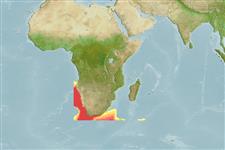>
Stomiiformes (Lightfishes and dragonfishes) >
Sternoptychidae (Marine hatchetfishes) > Maurolicinae
Etymology: Maurolicus: Greek,mauros, -os, -on = dark + Greek,lykos = wolf (Ref. 45335).
Environment: milieu / climate zone / depth range / distribution range
Ökologie
seewasser bathypelagisch; tiefenbereich 0 - 50 m (Ref. 58018). Deep-water; 6°N - 37°S, 10°E - 53°E
Southeast Atlantic: Along the continental slope of southwestern Africa. Western Indian Ocean: found in seamounts occurring in the area, with the most eastern record at 35°30'S, 53°E.
Size / Gewicht / Alter
Maturity: Lm ? range ? - ? cm
Max length : 4.7 cm SL Männchen/unbestimmt; (Ref. 26775)
Kurzbeschreibung
Morphologie | Morphometrie
Wirbelzahl: 33 - 35. AC photophores 22-27, usually 24-26. Head 29-31% SL, eye 10-11.5% SL, upper jaw 16-19% SL, maximum body depth well behind pectoral fin base 23-25%. Stomach pigmented, hind portion of intestine not pigmented (Ref. 26775).
Life cycle and mating behavior
Geschlechtsreife | Fortpflanzung | Ablaichen | Eier | Fecundity | Larven
Parin, N.V. and S.G. Kobyliansky, 1996. Diagnoses and distribution of fifteen species recognized in genus Maurolicus Cocco (Sternoptychidae, Stomiiformes) with a key to their identification. Cybium 20(2):185-195. (Ref. 26775)
IUCN Rote Liste Status (Ref. 130435)
Bedrohung für Menschen
Harmless
Nutzung durch Menschen
Mehr Information
NamenSynonymeMetabolismusRäuberÖkotoxikologieFortpflanzungGeschlechtsreifeAblaichenSpawning aggregationFecundityEierEientwicklung
Alter/GrößeWachstumLänge-GewichtLänge-LängeLängenhäufigkeitenMorphometrieMorphologieLarvenLarven Pop.Dyn.RekrutierungDichteBRUVS
ReferenzenAquakulturAquakultur ProfilZuchtlinienGenetikElectrophoresesVererbbarkeitKrankheitenVerarbeitungNutrientsMass conversion
PartnerBilderStamps, Coins Misc.LauteCiguateraGeschwindigkeitSchwimmstilKiemenoberflächeOtolithsGehirngrößeSehfähigkeit
Tools
Zusatzinformationen
Download XML
Internet Quellen
Estimates based on models
Preferred temperature (Ref.
123201): 14.7 - 21.1, mean 16.8 °C (based on 16 cells).
Phylogenetic diversity index (Ref.
82804): PD
50 = 0.5000 [Uniqueness, from 0.5 = low to 2.0 = high].
Bayesian length-weight: a=0.00479 (0.00196 - 0.01170), b=3.16 (2.95 - 3.37), in cm total length, based on LWR estimates for this (Sub)family-body shape (Ref.
93245).
Trophic level (Ref.
69278): 3.4 ±0.33 se; based on food items.
Widerstandsfähigkeit (Ref.
120179): mittel, Verdopplung der Population dauert 1,4 - 4,4 Jahre. (Assuming Fec < 1,000).
Fishing Vulnerability (Ref.
59153): Low vulnerability (10 of 100).
